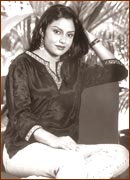|
DAILY NEWS ONLINE |
|
|
|
OTHER EDITIONS |
|
|
|
|
|
|
|
|
|
OTHER LINKS |
|
|
|
|
|
|
 |
|
Giving their best shots together againIn Jayantha Chandrasiri's 'Guerilla Marketing' which opens in Colombo tomorrow actresses Yasodha Wimaladharma and Sangeetha Weeraratne tussles over the same man. Prasad Abu Bakr asks the two leading stars if anything similar has ever happened off screen in their long spanning relationship as friends.
The present film, is their second together since a lapse of 10 years. The last was when they came together in Director Vasantha Obeysekara's 'Maruthaya' which was also their first film together. The film eventually led them to strike a friendship so close that Yasodha ended up as Sangeetha's bridesmaid at the latter's wedding. "But in this business time does not allow much leverage for any relationship to seek much time together, as amongst general friends" says Sangeetha. Yasodha agrees adding that their busy schedules won't permit them to fulfil certain obligations that are normally required to keep relationships afloat. In Chandrasiri's film they are not friends in that sense but two women who eventually seek each other for emotional support to save the man they both love (played by Kamal Addaraarachchi), to relieve him from a state of mental derangement he is undergoing. Talking of their co-stars in their respective movie careers they state that it is interesting and makes things easier if everybody work towards the same goal during a project. "I get very upset when my co-stars come on the set without remembering their lines as the producers are paying us to do a job and we should deliver the goods" said Sangeetha emphatically. The roles that they project in 'Guerilla Marketing' are more or less tailor made one would say, specially when you meet them in person. While Sangeetha is willing to sit on a hot seat and take off on an adventure seeking professional advancement Yasodha will ponder choosing her roles to suit her habitual personality of an introvert. In the course of their careers both actresses came head on in to competition in the year 2003 when their films 'Agni Dahaya' (also directed by Jayantha Chandrasiri with Yasodha playing the lead) and 'Salelu Varama' (directed by Vasantha Obeysekara featuring Sangeetha in the lead), but the jury failed or backed out from presenting the best actress award to either of them during that decisive moment, making it a landmark in the history of local cinema where a jury failed to decide the 'better one' of the two, both who gave their best performances that year. Now they are teamed together after 10 years; in a movie handling a contemporary theme related to modern day politics in comparison to what they portrayed then in 'Maruthaya'. Today both actresses probably are more mature and professional in their views and approach to performances and who knows they might be in competition with each other? But what is wise to believe for ourselves when we take a long look at the fragments of relationships that are left behind in realms of cinema as well as in politics (which Chandrasiri has added as an essence for his theme in 'Guerilla Marketing') is that in the corridors of power and competition there are no permanent friends, nor are there permanent enemies. The design and presentation of the opening night of the film is handled by Glenda Parthipan of Emphasis. Sunil Santha - the legend of 'Hela' music
|
|
|
Mounted first on 19 January 1898 at the Maryinsky Theatre, Petersburg, Raymonda was choreographed by Pashkova and Marius Petipa to the scoring of Glazunov. This production was a great success and was followed by different versions by companies who were keen on having a romantic ballet that could end up in their repertoires. The first production had Legnani, Legat and Gerdt.
In the ballet Raymonda is set to wed Jean de Brienne but is prevented for the moment by Abderakhaman who is a Saracen knight. He forces himself upon Raymonda while de Brienne is away on a mission. When Raymonda's lover returns at the crucial moment, he fights his rival who retreats.
De Brienne prepares for his wedding celebrations that climax with a spectacular and lavish Hungarian divertisement.
The USSR had constantly revived the ballet which is still held in repertoires of all leading ballet companies around the world. West first saw it in Zverev's version for the National Ballet of Lithuansia. This was mounted in London in 1935.
The abbreviated version of Danilova and Balanchine was the first that America saw and produced for ballet Russe de Monte Carlo in 1946.
A complete magnificent production was staged by Rudolf Nureyev for the touring Royal Ballet in 1964 just two years after his defection from Russia. This was limited for a festival. Nureyev mounted a further complete version for the Australian Ballet in 1965; for Zurich Opera Ballet in 1972 and for the American Ballet Theatre in 1975.
Every production of Nureyev had different scores but mainly it was Glazunov. Raymonda was staged for the first time in Russia by Alexander Gorsky in 1900.
The White Lady and the King of Hungary were ommited in this version. In 1945 Lenoid Lavrosky made his version for the Bolshoi Theatre and in 1984 Yury Grigorovich recreated. Among the great ballerinas to dance this role in Russia lately were Nataliya Bessmertova, Ludumilla Senenyaka, Nina Annanashvilla among the new crop of dancers.
In the Three-Act Ballet which is set in the Chateau De Doris in Provence, Raymonda is the neice of the Countess, Sybil De Doris and engaged to be married to knight, Jean De Brienne. Jean has to bid farewell to Raymonda before he goes out on a crusade which is to be led by the Hungarian King, Andrew II.
Sad by his departure, Raymonda remains in a terrace with her friends when she is apprehended by the vision of the White Lady. As she falls asleep she is led by this apparition to an enchanted garden where a vision of Jean de Brienne appear who dances passionately with her.
Suddnely Jean disappears and instead she is faced with a Saracen warrior whom she does not know. He passionately begs for her love and is horrified at the suggestion. Raymonda falls unconscious and when she wakes up later, the vision disappears but not before Raymonda realises that the dream is an indication to what is in store for her.
A few days after this incident, festivities are under way in the ballroom of the castle. With a magnificent retinue, a Saracen warrior enters the ballroom. She recognises him as the Saracen, Abderakham of her dream. He strides up to her and offers her a treasury laded with gold and jewels, asking her hand in marriage. The young Raymonda is horrified as she rejects him.
Abderakham attempts to abduct her when the King of Hungary appears from the crusade along with Jean and the rest of his Court. After comprehending the situation, King Andrew II orders a single combat between Jean and Abderakham and Jean swiftly defeats his foe. Raymonda and Jean are reunited.
In the last scene, King Andrew II bless the marriage of Jean and Raymonda. To honour the king, the wedding festivities conclude with a Hungarian divertisment which the King enjoys very much.
Raymonda is not much of a story nor has it any story value other than a royal mix-up of incidents, unrelating to each other. But the dancers have made it a spectacular ballet to be retained in the repertories of all leading ballet companies.
|
|
 |
 |
 |
 |
 |


 "Who knows, we might have" says Sangeetha, settling herself into a
chair. The bubbly actress is quick with her reflexes in thinking out her
answers in comparison to her counterpart Yasodha who looks at her
questions in depth while an answer is sorted out.
"Who knows, we might have" says Sangeetha, settling herself into a
chair. The bubbly actress is quick with her reflexes in thinking out her
answers in comparison to her counterpart Yasodha who looks at her
questions in depth while an answer is sorted out. 
